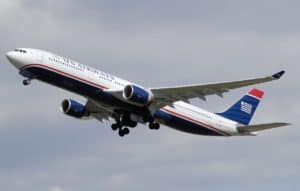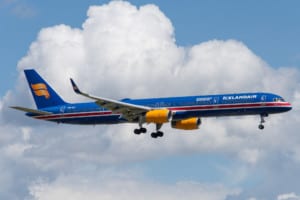When it comes to commercial airliners, there are two leading players in the game: Airbus and Boeing. Both companies have a wide range of models that cover different sizes and passenger capacities. In this article, we will compare the A-330 vs 757.
| Aircraft: | Airbus A330-300 | Boeing 757-300 |
|---|---|---|
| Photo: |
 |
 |
| Country: | France | United States |
| Manufactured: | from: 1993 to: Present | from: 1998 to: 2004 |
| ICAO: | - | B753 |
| Price: | $264.2 million | $80 million |
| Avionics: | Rockwell Collins Avionics | Rockwell Collins Avionics |
| Engine: | 2 X General Electric CF6 | 2x Rolls-Royce RB211-535E4/B, Pratt & Whitney PW2000-40/43 |
| Engine Type: | - | Turbofan |
| Power: | 71,100 pound-force | 43,500 pound-force |
| Max Cruise Speed: |
470 knots 870 Km/h |
496 knots 919 Km/h |
| Approach Speed (Vref): | - | 140 knots |
| Travel Range: |
6,350 Nautical Miles
11,760 Kilometers |
3,467 Nautical Miles
6,421 Kilometers |
| Fuel Economy: |
0.26 nautical mile / gallon 0.127 kilometres / litre |
0.3 nautical mile / gallon 0.147 kilometres / litre |
| Service Ceiling: | 41,100 feet | 42,000 feet |
| Rate of Climb: | - |
3500 feet / minute 17.78metre / second |
| Take Off Distance: |
2770 metre 9,087.82 feet |
2600 metre 8,530.08 feet |
| Landing Distance: |
1730 metre 5,675.78 feet |
1550 metre 5,085.24 feet |
| Max Take Off Weight: |
242,000 Kg 533,513 lbs |
123,830 Kg 272,996 lbs |
| Max Landing Weight: | - |
101,610 Kg 224,009 lbs |
| Max Payload: |
45,900 Kg 101,191 lbs |
30,940 Kg 68,210 lbs |
| Fuel Tank Capacity: |
36,744 gallon 139,091 litre |
11,490 gallon 43,494 litre |
| Baggage Volume: |
158.4 m3 5,594 ft3 |
67.5 m3 2,384 ft3 |
| Seats - Economy: | 335 seats | 295 seats |
| Seats - Business Class: | 295 seats | 243 seats |
| Seats - First Class: | - | - |
| Cabin Height: |
2.54 metre 8.33 feet |
2.13 metre 6.99 feet |
| Cabin Width: |
5.28 metre 17.32 feet |
3.54 metre 11.61 feet |
| Cabin Length: |
50.35 metre 165.19 feet |
43.21 metre 141.76 feet |
| Exterior Length: |
63.6 metre 208.66 feet |
54.43 metre 178.57 feet |
| Tail Height: | - | 13.64 metre - 44.75 feet |
| Fuselage Diameter: |
5.64 metre 18.50 feet |
3.76 metre 12.34 feet |
| Wing Span / Rotor Diameter: |
60.3 metre 197.83 feet |
38.06 metre 124.87 feet |
| Wing Tips: | No Winglets | Blended Tips |
| More Info: | Airbus A330-300 | Boeing 757-300 |
|
Data presented is for entertainment purposes and should not be used operationally.
|
Other Airbus A330-300 comparisons:
Other Boeing 757-300 comparisons:
Airbus A330
The Airbus A330 is a twin-engine widebody aircraft that can seat up to 300 passengers. It has a range of 11,000 kilometers and a cruising speed of 870 kilometers per hour. The A-330 is equipped with fuel-efficient turbofan engines and an advanced wing design, which make it one of the most efficient and reliable aircraft in its class.
The A-330 is also highly versatile and can be operated as a cargo plane, a troop carrier, or a medical evacuation aircraft. In addition, the A-330 has an excellent safety record, with only three hull loss accidents in its 25-year history.
As a result, the A-330 is widely considered one of the world’s safest and most reliable aircraft.
Why was the Airbus A330 developed?
The Airbus A-330 was developed by the European aviation industry as a response to the Boeing 747. The 747 was a wide-body jetliner that was first introduced in 1970, and it quickly became the standard for long-distance travel.
The A-330 was developed to compete with the 747, and it was introduced in 1993. The A-330 is a twin-engine, wide-body jetliner that can seat up to 335 passengers.
It has a range of 6,700 nautical miles, and it can fly at a cruising speed of Mach 0.85.
The A-330 is used by some major airlines, including Air France, Delta Air Lines, and United Airlines. It has been involved in many high-profile incidents, including the 2009 Air France Flight 447 crash.
What purpose does the Airbus A-330 serve?
The Airbus A-330 is a wide-body jet airliner designed and produced by Airbus. It is commonly used for long-haul flights, carrying between253 and293 passengers.
The A-330 has a range of 5,650 to 9,400 nautical miles, making it suitable for transcontinental flights. It is also one of the most fuel-efficient aircraft in its class, with a fuel burn rate of just over 4 gallons per hour. The A-330 first entered service in 1993 and has since been flown by over 100 airlines around the world.
It has become one of the most popular wide-body jets in service, with over 1,700 aircraft delivered as of June 2019.
Boeing 757
The Boeing 757 is a twin-engine jet that was first introduced in 1983. It was designed for shorter routes and can seat between 210 and 239 passengers, depending on the configuration. The 757 is classified as a narrow-body aircraft, which means that it has two aisles with rows of seats on either side.
The 757 has a range of approximately 3,900 nautical miles, making it ideal for transcontinental flights. It is powered by two Pratt & Whitney PW2037 turbofan engines, each of which produces 43,500 pounds of thrust. The 757 has a cruising speed of 564 mph and is capable of reaching a top speed of 610 mph. With its advanced aerodynamic design, the 757 can take off and land on shorter runways than other comparable aircraft.
Why was the Boeing 757 developed?
The Boeing 757 was developed in the early 1980s by the US aviation industry as a response to the increasing demand for short-haul flights. The 757 is a twin-engine, medium-range aircraft that can seat up to 189 passengers.
It’s one of the most fuel-efficient jets in its class and has a range of 3,700 nautical miles. The 757 has been used by major airlines all over the world, including American Airlines, United Airlines, and Delta Air Lines.
More than 1,000 757s have been delivered since it entered service in 1983.
What purpose does the Boeing 757 serve?
The Boeing 757 is a mid-size, single-aisle jet airliner that was designed and manufactured by Boeing Commercial Airplanes. First introduced in 1983, the 757 was designed as a replacement for the smaller 727 and 737 models.
The 757 has since become one of the most popular jetliners in the world, with over 1,000 aircraft delivered to airlines around the globe. Today, the 757 remains an important part of many airlines’ fleets, serving both short- and long-range routes.
Thanks to its fuel efficiency and range, the 757 is well-suited for transcontinental and transatlantic flights. Additionally, its cargo capacity makes it ideal for freight operators.
With its wide array of uses, it’s no wonder that the Boeing 757 continues to be one of the most versatile jetliners in service.
Differences Between the Airbus A330 & Boeing 757
Airbus A-330 and Boeing 757 are both twin-engine, long-haul aircraft that can carry a lot of passengers over long distances. They are both popular choices for airlines, but there are some key differences between the two models. The A-330 has a wider body than the 757, which gives it more space for passenger comfort and cargo.
It also has a longer range, meaning it can fly non-stop for longer distances. The 757 is lighter and faster than the A-330, making it better suited for shorter flights or flights with less cargo.
It also uses less fuel than the A-330, which makes it more efficient and environmentally friendly.
Similarities Between the Airbus A330 & Boeing 757
The Airbus A-330 and the Boeing 757 are both twin-engine jetliners that were developed in the 1970s.
Both aircraft are widely used for long-range passenger flights. The A-330 is a wide-body aircraft, while the 757 is a narrow-body aircraft. Both aircraft have a maximum range of over 8,000 miles. The A-330 has a higher cruising speed than the 757, but the 757 has a higher rate of climb.
Both aircraft have three main landing gear legs and a T-tail configuration. The A-330 is powered by two turbofan engines, while the 757 is powered by two high-bypass turbofan engines.
The A-330 has a larger fuselage than the 757, which can accommodate more passengers and cargo. Both aircraft are equipped with winglets to improve fuel efficiency.
Airbus A330: The Better
The Airbus A-330 is a better airplane than the Boeing 757 for several reasons. First, the A-330 has a wider fuselage, which provides more space for passengers and cargo.
Second, the A-330 is equipped with more modern engines, which are more efficient and offer better performance. Third, the A-330 has a longer range than the 757, meaning it can fly farther without refueling. Finally, the A-330 is simply a newer airplane; it first flew in 1992, while the 757 first flew in 1983.
Boeing 757: The Better
For starters, the 757 is a much newer plane than the A-330. It was first introduced in 1983, while the A-330 didn’t make its debut until 1992. That might not seem like a big difference, but it means that the 757 is equipped with more modern technology and features than the A-330.
It also has a wider body than the A-330, which allows for more passenger and cargo space. And speaking of cargo, the 757 can carry more cargo than the A-330 thanks to its larger cargo doors.
In terms of performance, the 757 outperforms the A-330 in several key areas. It has a longer range, meaning it can fly longer distances without needing to refuel. It can also fly at higher altitudes, which results in a smoother ride for passengers.
And thanks to its advanced engines, it’s able to take off and land on shorter runways than the A-330.
Conclusion
The A-330 and 757 are both popular aircraft that have been in service for decades. Both planes offer long-range capabilities, plenty of passenger and cargo space, and comfortable rides.
However, the A-330 is the better choice for airlines looking for a wide-body jetliner with more modern features and technology. It has a longer range than the 757, as well as more spacious cabins for passengers.
The 757 is lighter than the A-330, making it more efficient and better suited for shorter flights or flights with less cargo. So whether you’re transporting passengers or freight, the A-330 and 757 can both get the job done – just pick whichever aircraft fits your needs best!


